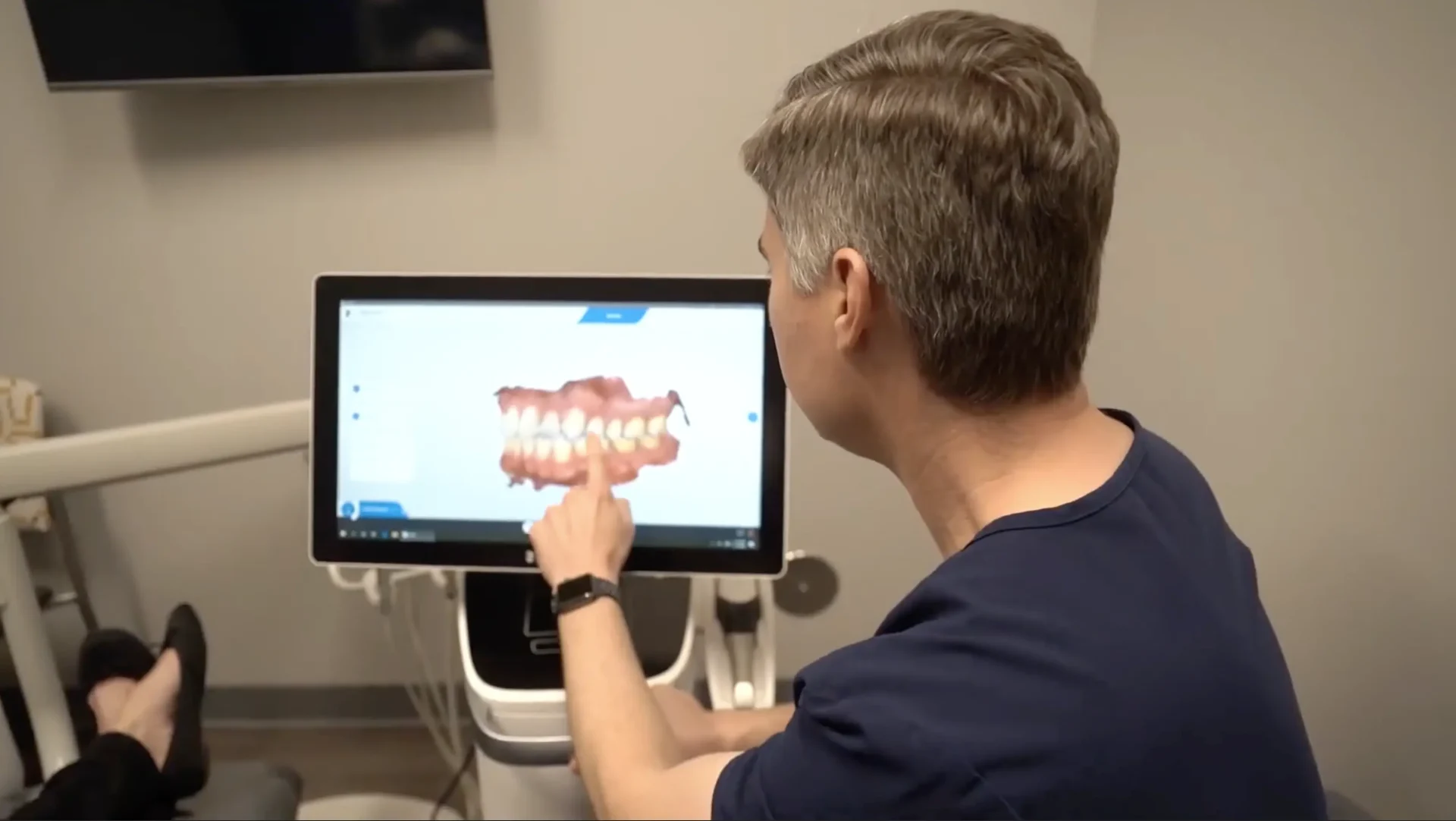Perfect dental crowns come from careful steps that protect your tooth and match your smile. First comes a detailed exam and photos. Then the dentist prepares the tooth with a light touch, removing only what is necessary for a strong fit. Digital scans capture every ridge so the lab can model your tooth in 3D. Shade guides help find the right color, not just “white.”
In the lab, technicians layer ceramics for depth, polish edges, and test the bite on a model. At delivery, the team checks, adjusts, seals, and polishes. The goal is simple. Your crown should feel natural from day one.
What is the Process For Creating a Custom Dental Crown?
A crown is a tailored suit for your tooth with tight tolerances and daily wear. Here is the roadmap.
Diagnosis & Game Plan
Start with the “why.” Cracks, large fillings, and post–root canal teeth need stability and function. The team reviews your bite, nearby teeth, and gum health to solve the whole problem.
Preparation (Make Room for the Suit)
The dentist shapes the tooth minimally to fit the chosen material. Smooth margins and gentle transitions protect strength. Less is more.
Records That Matter
- Impressions or Intraoral Scans: Digital scans create a precise 3D model without putty or gagging.
- Bite Registration: Records how your teeth meet so the crown is not high, low, or bulky.
- Photographs: Smile and close-up photos guide color and surface detail.
Temporization
A well-made temporary protects the tooth, keeps gums healthy, holds space, and test-drives shape and bite.
Design & Fabrication
Same-day CAD/CAM crowns are designed and milled in-office. Lab crowns go to a ceramist for layered color and finishing. Both paths aim for accuracy, strength, and a natural look.
Try-In & Fine-Tuning
The dentist checks margins, contacts, and bite. Tiny high spots are adjusted by microns because your jaw feels very small changes.
Cementation & Sealing the Deal
Bonding varies by material. The team keeps the tooth clean and dry, removes excess cement, confirms floss glide, and rechecks your bite.
Clear communication among dentist, assistant, technician, and you keeps shade, shape, and strength aligned.
How Do Dentists Ensure a New Crown Matches Tooth Color?
Matching color is part science and part art. Natural teeth show gradients of light and warmth from gumline to edge. Here is how teams get it right.
Neutral Lighting & Visual Calibrations
Color-correct lighting and neutral backgrounds prevent false reads. Teeth must stay hydrated during shade checks since dry enamel looks chalky.
Shade Guides, Digital Tools, and Photos
- Shade Tabs: Compare lightness and saturation in real time.
- Spectrophotometers: Provide objective color data for the lab.
- High-Quality Photos: Capture translucency, surface texture, and small character lines.
Map, Don’t Guess
Teams “map” deeper color near the neck and more translucency at the edge. This guide directs lab layering or in-office staining and glazing.
Texture & Gloss
Natural teeth have micro texture that scatters light. Proper finishing and the right sheen make the crown disappear.
For a single front tooth, the office may schedule a custom shade visit or a stain-and-glaze appointment for fine-tuning.
What Technology is Used to Design and Mill Dental Crowns?
Modern tools boost accuracy and comfort.
Intraoral Scanners
Scanners create a clean 3D map with no bubbles or distortion. This file drives the whole process.
CAD Design
Software proposes a starting shape based on your bite and neighbors. The dentist refines contact strength, cusp height, and emergence profile with precise controls.
CAM Milling Units
Mills carve crowns from ceramic or zirconia blocks with diamond burs. They are fast and consistent.
Sintering Ovens and Furnaces
Zirconia is milled soft, then fired at high temperatures to reach final strength and translucency.
Stain, Glaze, and Polishing
Color and gloss are added after milling. A high polish looks great, resists plaque, and treats opposing teeth gently.
Technology helps, but skilled eyes and hands make the final call.
How are Different Materials Like Porcelain and Zirconia Shaped Into Crowns?
Material choice depends on location, bite force, and esthetics.
Porcelain and Lithium Disilicate
Best for: Front teeth and many premolars.
Look and feel: Lifelike translucency and warmth.
Workflow: Designed digitally, milled from a glass-ceramic block, crystallized in a furnace, stained, glazed, and polished.
Why choose it: Natural appearance and excellent fit.
Zirconia (Monolithic and Layered)
Best for: Molars, strong bites, and areas that need durability.
Look and feel: Newer multi-layer versions blend strength with better translucency and shade gradients.
Workflow: Milled soft, then sintered to full strength, stained, glazed, and polished.
Why choose it: Very strong, conservative on tooth structure, kind to opposing teeth when polished well.
Hybrid and Composite Ceramics
Best for: Same-day crowns and onlays where gentle wear is helpful.
Look and feel: Comfortable, enamel-like wear.
Workflow: Milled chairside, bonded with modern adhesives, polished smooth.
Why choose it: Speed, comfort, and attractive results for select cases.
Layering and Characterization
For high-esthetic cases, ceramists hand-layer porcelain over a core to sculpt color and translucency. For back teeth that need strength, a single-material crown often makes the most sense.
Shaping the Bite (Occlusion)
Your crown must work with neighbors and the opposing arch. The team shapes functional cusps, adds escape paths for food, and sets contact points so floss snaps cleanly. They design guidance so your jaw moves without the crown catching.
Small Details That Make a Big Difference
- Tissue-Friendly Margins: Smooth, continuous margins help gums stay comfortable.
- Emergence Profile: The way the crown rises from the gum affects appearance and flossing.
- Polish Over Glaze Alone: A high mechanical polish lasts and is gentle to opposing teeth.
- Cement Choice: The right adhesive for the material and prep supports long-term success.
Myth Busting (Because You’re Wondering)
“Crowns always look fake.”
Modern ceramics, shade mapping, and texture make crowns blend in, even under bright lights.
“Zirconia will wear my other teeth.”
Poor finishing can be abrasive. Properly polished zirconia is very kind. Finish matters more than brand.
“One-appointment crowns are lower quality.”
Not by default. Same-day crowns can be excellent in the right hands. Complex color cases may benefit from a ceramist’s touch.
Living With Your New Crown (Comfort Tips That Help)
- Give it 24 to 48 hours to feel normal.
- If the bite feels “tappy” or you avoid that side, call. Tiny adjustments help.
- Use a soft brush and glide-style floss. Water flossers help tight spots.
- If you clench at night, ask about a custom nightguard.
River District Dentistry Smiles Presents: “The Crown You’ll Forget About in the Best Way”
A crown should vanish into your smile and work quietly for years. If you have a cracked tooth, a failing filling, or a post–root canal tooth that needs strength, we can help you feel confident again.
Here is our behind-the-scenes promise:
- Thoughtful planning that respects your tooth and your bite
- Digital scans and precise design for margins that keep gums healthy
- Material selection tuned to your goals for beauty, strength, or both
- Shade matching guided by real photos and clear notes
- Finishing and polishing that feel like natural enamel
Ready for a crown that looks like it grew there? Book your dental crown visit with River District Dentistry Smiles. Get the careful mix of technology, craft, and kindness right where you chew.


